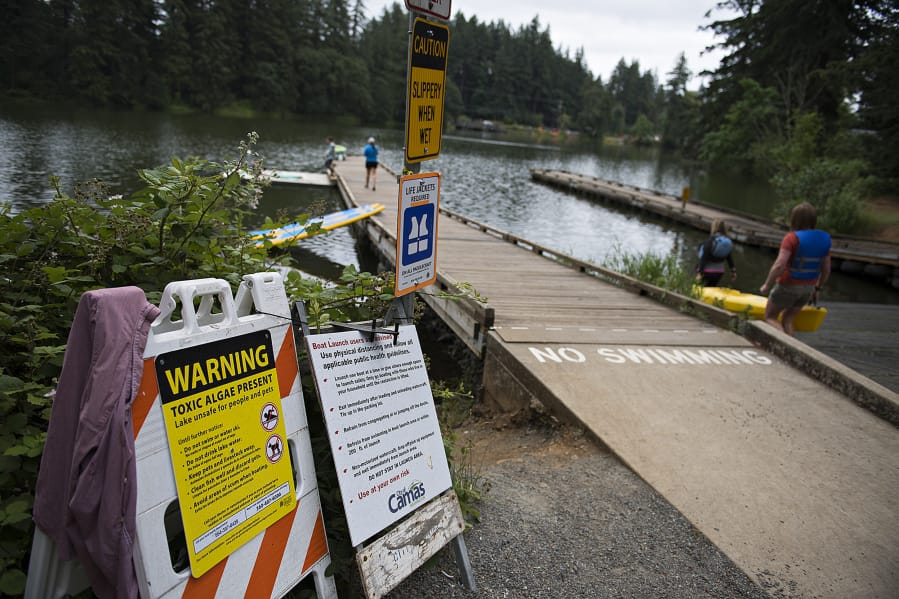For those coming into increasing contact with Washington’s lakes as they warm up throughout the summer, being aware of harmful algae blooms could save the life of their pet and prevent exposure to themselves. Blue-green algae, also known as cyanobacteria, typically grows in lakes, rivers, ponds, estuaries and marine water, according to the Washington State Department of Health, but not all blooms are toxic. Blooms tend to be found on shorelines.
“There have been increases in the number of cyanobacteria blooms and duration, in general. A cool, wet spring should hopefully help this year, but we will see how it goes. After the heat wave last weekend, the number of lakes blooming went up from about four to 16,” Lizbeth Seebacher, Washington Department of Ecology Wetland & Aquatic Ecologist wrote in an email to The Bellingham Herald.
Harmful algae blooms produce toxins that can poison humans, pets and wildlife, according to the Washington State Lake Protection Association. They commonly begin to occur near the start of summer and continue until the autumn. For the most recent toxicity information, the Washington State Toxic Algae website worked with the Washington Department of Ecology to create a live, interactive map of lakes that have been tested for toxic algae and their safety levels.
If your pet comes into contact with the toxic algae, the effects could be severe or even fatal, and drinking water that is contaminated has been known to kill pets.
When visiting a lake or other body of water, be on the lookout for any yellow or red warning signs that will inform visitors of toxic algae and closures as well as algae blooms. Blue-green algae typically look like green paint floating on top of the water, but its color can also look blue, brown or reddish-green. Algae can also look like colored scum, foam or streaks along the surface of the water.
How toxic algae affects humans and pets
Toxic algae blooms can be extremely dangerous to both humans and pets by producing nerve and liver toxins.
Nerve toxins, or nerve poisoning can cause people to experience dizziness, tingling in fingers and toes and numbness of lips. A skin rash is also a possible symptom. In animals, nerve toxins cause weakness, difficulty breathing, staggering, convulsions and death. Signs of nerve poisoning typically occur within 15 to 20 minutes after ingesting algae or being in contact.
Liver toxins, also known as hepatotoxin or liver poisoning can cause both people and animals to experience vomiting, abdominal pain and diarrhea or even kill animals. Signs of liver poisoning take longer to appear than nerve poisoning, taking hours or even days before any side effects begin.
How to know if algae are toxic
There are a few signs that an algae bloom is toxic, according to the Washington State Department of Health:
- Dead fish or animals near the algae bloom.
- Skin rashes on humans after swimming in the water.
- Sudden sickness or death of a dog or cat, especially if algae can be seen on its legs, feet or mouth.
What to do if you see algae
Protecting yourself, your family and your pets from algae is extremely important. If you see algae blooming, here’s what to do:
- When you are not sure if an algae bloom is toxic or not, stay away from the bloom and out of the water.
- Contact your local health department to report the algae so that the lake can be tested. To find your local health department, visit the Washington State Toxic Algae website for a complete contact list by county. Whatcom County’s Department of Health can be contacted by calling Tom Kunesh at 360-676-6724, or by emailing tkunesh@whatcomcounty.us.
If your pet comes into contact with algae
If your dog or other animals swim in contaminated water, drink water or even touch algae, the next steps you take could save their lives, according to the Washington State Department of Health.
If your pet goes into contaminated water, rinse them with clean water immediately, do not let them lick their fur and rinse your own hands and exposed skin.
Citizens are also asked to report animal poisonings to their local health department.
If your pet shows any signs of seizures, tremors, paralysis, diarrhea, not eating, drooling, vomiting, low energy or weakness, call your veterinarian immediately.



